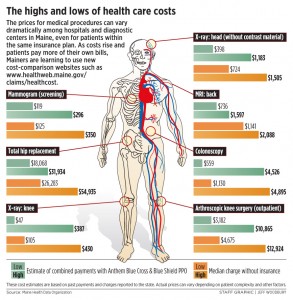 The Dartmouth Atlas and other health cost analysts have exposed the phenomenon of varying health costs, from the state of Florida to California, Oregon to McAllen, Texas.
The Dartmouth Atlas and other health cost analysts have exposed the phenomenon of varying health costs, from the state of Florida to California, Oregon to McAllen, Texas.
Now we have evidence of big cost disparities within a relatively small state – the State of Maine. Details on this story appear in the May 16th 2010 Portland Press Herald, which created the illustration shown here based on pricing data collected throughout the state.
Health citizens in Maine are fortunate to have a state-funded resource that aggregates and analyzes data on health care cost and quality from health care providers in the state, collected by the Maine Health Data Organization (MHDO) and the Maine Quality Forum (MQF). The state legislature has mandated that a database be built by September 2010 that provides detailed, current health cost and quality data for Maine’s citizens to use for health decision support.
MHDO found that in one part of Maine, a colonoscopy cost $600 for a fully-insured patient; in another part of Maine, an uninsured patient is charged over $4,800. A hip replacement costs $15,000 in one hospital, and $38,000 in another.
![]() All (or nearly all) health care is local, and health financing largely determines how health care is delivered in a locality. According to the Maine Hospital Association, Medicare covers 40% of the surgical procedures done in the state, but pays only 79% of the costs.
All (or nearly all) health care is local, and health financing largely determines how health care is delivered in a locality. According to the Maine Hospital Association, Medicare covers 40% of the surgical procedures done in the state, but pays only 79% of the costs.
Cost-shifting between those-who-have coverage and those-who-have-not is normal throughout U.S. local health markets. “Why should the (uninsured) people who have the least bargaining clout be paying the highest prices? Because the providers can charge them the highest prices, and that’s completely unfair,” the director of Maine’s Consumers for Affordable Healthcare told the Herald.
The theory is that health report cards and databases such as the MHDO’s and MQF’s will provide useful information that will help purchasers of health care — both individual health citizens and sponsors of plans like employers and government agencies — make better buying decisions that ultimately drive down costs. Bending the cost curve is a complicated affair, but there is gathering evidence that shining a light on health cost and quality disparities will help to do so from the Commonwealth Fund, Tufts, and the Robert Wood Johnson Foundation, among other researchers.




 I'm in amazing company here with other #digitalhealth innovators, thinkers and doers. Thank you to Cristian Cortez Fernandez and Zallud for this recognition; I'm grateful.
I'm in amazing company here with other #digitalhealth innovators, thinkers and doers. Thank you to Cristian Cortez Fernandez and Zallud for this recognition; I'm grateful. Jane was named as a member of the AHIP 2024 Advisory Board, joining some valued colleagues to prepare for the challenges and opportunities facing health plans, systems, and other industry stakeholders.
Jane was named as a member of the AHIP 2024 Advisory Board, joining some valued colleagues to prepare for the challenges and opportunities facing health plans, systems, and other industry stakeholders.  Join Jane at AHIP's annual meeting in Las Vegas: I'll be speaking, moderating a panel, and providing thought leadership on health consumers and bolstering equity, empowerment, and self-care.
Join Jane at AHIP's annual meeting in Las Vegas: I'll be speaking, moderating a panel, and providing thought leadership on health consumers and bolstering equity, empowerment, and self-care.